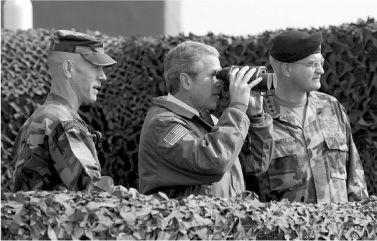Read The Definitive Book of Body Language Online
Authors: Barbara Pease,Allan Pease
The Definitive Book of Body Language (26 page)

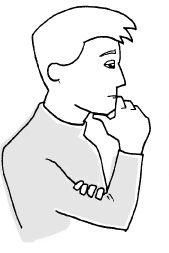
Making a decision

Female version of Chin Stroking
When you've asked the listeners for their decision and they start Chin Stroking, their next gestures will signal whether their decision is negative or positive. Your best strategy is to stay quiet and watch their next gestures, which will indicate the decision reached. For example, if the Chin Stroke is followed by crossed arms and legs and the person sits back in their chair, it's a fair bet the answer will be no. This gives you an early opportunity to resell the benefits before the other person verbalizes no and makes it harder to reach agreement.
If the Chin Stroke is followed by leaning forward with arms open or picking up your proposal or sample, chances are you have a yes and can proceed as if you have agreement.
Someone who wears glasses sometimes follows an evaluation cluster by taking off their glasses and putting one arm of the frame in the mouth instead of using the Chin Stroke when making their decision. A cigarette smoker will take a puff of smoke. When a person puts a pen or a finger in their mouth after
you've asked for a decision, it's a signal that he is unsure and reassurance is needed. The object in the mouth allows him to stall and not feel any urgency in giving an immediate response.
Sometimes boredom, evaluation, and decision-making gestures come in combinations, each showing different elements of the person's attitude.
The next illustration shows the evaluation gesture moved to the chin, and the hand may also be stroking the chin. This person is evaluating the proposition and drawing conclusions simultaneously.
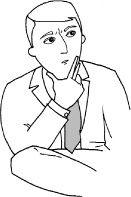
Evaluation-decision-making cluster
When the listener begins to lose interest in the speaker, the head begins to rest on the hand. The next picture shows evaluation with the head supported by the thumb as the listener becomes uninterested.
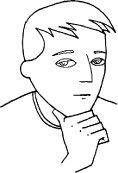
Evaluation, decision, boredom cluster
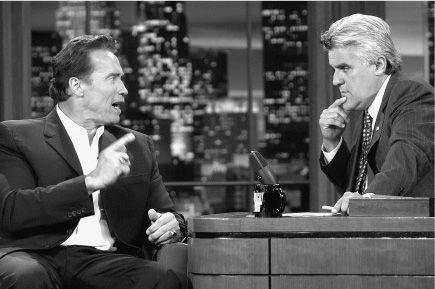
Arnold Schwarzenegger drives home his
point while the TV host thinks it over
When you say someone “gives you a pain in the neck,” you are referring to the ancient reaction of the tiny erector pillae muscles on the neck—often called goose bumps—attempting to make your nonexistent fur pelt stand on end to make yourself appear more intimidating because you are feeling threatened or angry It's the same hair-raising reaction an angry dog has when it's confronted by another potentially hostile dog. This reaction causes the tingling feeling you experience on the back of your neck when you feel frustrated or fearful. You'll usually rub your hand over the area to satisfy the sensation.
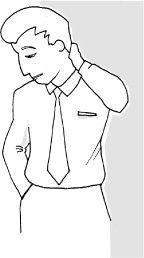
“Pain in the neck” gesture
Let us assume, for example, that you asked someone to do a small favor for you and that they had forgotten to do it. When you ask them for the result, they slap either their forehead or back of the neck, as if they were symbolically beating themselves. Although slapping of the head is used to communicate forgetfulness, it's important to watch whether they slap the forehead or neck. If they slap their forehead, they signal that they are not intimidated by you mentioning their forgetfulness. When they slap the back of the neck to satisfy the raised erector pillae muscles, however, it tells you that you are literally a “pain in the neck” for mentioning it. If the person slaps their rear end, however…
Gerard Nierenberg, of the Negotiation Institute in New York, found that those who habitually rub the back of the neck have a tendency to be negative or critical, whereas those who habitually rub their foreheads to nonverbalize an error tend to be more open and easygoing.
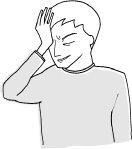
Punishing oneself by slapping oneself
Acquiring the ability to interpret hand-to-face gestures accurately in a given set of circumstances takes time and observation. When a person uses any of the hand-to-face gestures discussed in this chapter, it's reasonable to assume a negative thought has entered his mind. The question is, however, what is the negative thought? It could be doubt, deceit, uncertainty, exaggeration, apprehension, or outright lying. The real skill is the ability to interpret which negative is the correct one. This can best be done by an analysis of the gestures preceding the hand-to-face gesture and interpreting it in context.
We have a colleague, Bob, who enjoys playing chess. We challenged him to a competition, which we secretly videotaped for later analysis of his body language. The video revealed that Bob often rubbed his ear or touched his nose during the game, but only when he was unsure of his next move. We discovered that when we signaled an intention to move a chess piece by touching it, Bob's body language would signal what he thought about the proposed move. When he felt he could beat a move, and had probably already thought of a countermove, he'd signal his confidence by Steepling; when he was uncertain or unhappy he'd use the Mouth Cover, Ear Grab, or Neck Scratch. This happened with such predictability that when we secretly explained Bob's cues to the other members of our chess group, soon most could beat poor old Bob by anticipating his thoughts from his body language. Bob has not been offered a copy of this book.
During a videotaped role-play interview, our interviewee suddenly covered his mouth and rubbed his nose after he had been asked a question by the interviewer. He used the Mouth Cover for several seconds before answering, then returned to his open pose. Up to that point in the role play, the interviewee had kept an open posture with his coat unbuttoned, palms visible, nodding his head, and leaning forward when he answered questions, so we thought the gestures might have been isolated or out of context. On reviewing the videotape, we asked him about the hand-to-mouth gesture and he said that when he was asked the question, he thought he could have responded in two ways: one negative, one positive. As he thought about the negative answer and of how the interviewer might react to it, he covered his mouth. When he thought of the positive answer, however, his hand dropped away from his mouth and he
resumed an open posture. His uncertainty about the interviewer's possible reaction to the negative reply had resulted in the sudden Mouth Cover.
This illustrates how easy it can be to misinterpret a hand-to-face gesture and to jump to wrong conclusions.
EYE SIGNALS
